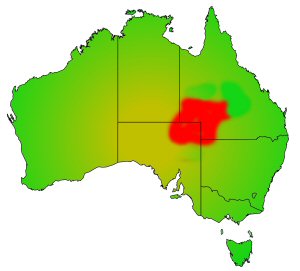Barcoo grunter
|
Click to enlarge |
|
|
Scientific name
Scortum barcoo
Other Common Names
Jade perch
Size
Up to 350 mm, commonly 250 mm.
Conservation Status
Not evaluated under IUCN Redlist
Habitat
Generally found in turbid or muddy waters of large low gradient rivers and waterholes in central Australia. Tolerates water temperatures up to 40°C.
Distribution
 Primarily the Barcoo River and Cooper Creek, the Lake Eyre and Bulloo-Bancannia drainages in central Australia as well as the Gilbert River and its tributaries in northern Queensland.
Primarily the Barcoo River and Cooper Creek, the Lake Eyre and Bulloo-Bancannia drainages in central Australia as well as the Gilbert River and its tributaries in northern Queensland.
History
A robust fish with a small head. Often confused with Welch’s grunter Bidyanus welchi and the silver perch Bidyanus bidyanus, most easily defferentiated by the dark blotches often found on the sides of Barcoo grunter.
Reproduction
Opportunistically breeds during floods, depositing the eggs on the bottom. The male guards and fans the eggs.
Diet
Omnivorous, eats other fish, crustaceans, molluscs and insects.
Angling
Minimum size in Queensland is 30 cm, with a combined bage limit of Barcoo grunter, Welches grunter and silver perch of 5 fish, no more than 2 of these may be silver perch..
On the table
Good eating, fillet the fish, leaving the skin on. Gently shallow fry skin down until skin is crispy and then turn over for a short while for finish off. Goes well with a mustard or cheese white sauce. Also good smoked. High in Omega 3 fatty acids. A superiour table species compared to some other Australian native fish
In the aquarium & aquaculture
Now being bred for the aquaculture industry, aquarium use and human consumption. Best kept in an aquaria with similar sized fish. An excellent aquaculture subject, easy to keep and has rapid growth reaching 300 mm in about 18 months. Recomended temperature range 18-27°C, but in aquaculture reported minimum is 13°C. May be fed barraundi pellets, lettuce and other plant leaves.